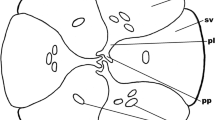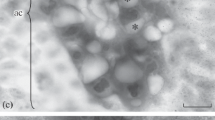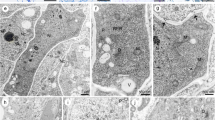Abstract
The nucellar ultrastructure of apomictic Panicum maximum was analyzed during the meiocytic stage and during aposporous embryo sac formation. At pachytene the megameiocyte shows a random cell organelle distribution and sometimes only an incomplete micropylar callose wall. The chalazal nucellar cells are meristematic until the tetrad stage. They can turn into initial cells of aposporous embryo sacs. The aposporous initials can be recognized by their increased cell size, large nucleus, and the presence of many vesicles. The cell wall is thin with few plasmodesmata. If only a sexual embryo sac is formed, the nucellar cells retain their meristematic character. The aposporous initial cell is somewhat comparable to a vacuolated functional megaspore. It shows large vacuoles around the central nucleus and is surrounded by a thick cell wall without plasmodesmata. In the mature aposporous embryo sac the structure of the cells of the egg apparatus is similar to each other. In the chalazal part of the egg apparatus the cell walls are thin and do not hamper the transfer of sperm cells. Structural and functional aspects of nucellar cell differentiation and aposporous and sexual embryo sac development are discussed.
Similar content being viewed by others
References
Abeln YS, Wilms HJ, van Wijk AJP (1985) Initiation of asexual seed production in Kentucky bluegrass, Poa pratensis L. In: Willemse MTM, Went JL van (eds) Proceedings of the 8th International Symposium on Sexual Plant Reproduction. Pudoc, Wageningen, pp 160–164
Battaglia E (1963) Apomixis. In: Maheswari P (ed) Recent advances in the embryology of angiosperms. University of Delhi, India, pp 221–264
Bell PR (1992) Apospory and apogamy: implications for understanding the plant live cycle. Int J Plant Sci 153:123–136
Brown WH, Emery WHP (1958) Apomixis in Gramineae. Tribe Andropogoneae. Bot Gaz 118:246–253
Carman JG, Grane CF, Riera-Lizarazu O (1991) Comparative histology of cell walls during meiotic and apomeiotic megasporogenesis in two hexaploid Australian Elymus species. Crop Sci 31:1527–1532
Dickinson HG (1981) Cytoplasmic differentiation during microsporogenesis in higher plants. Acta Soc Bot Pol 50:3–12
Dickinson HG, Heslop-Harrison J (1977) Ribosomes, membranes and organelles during meiosis in angiosperms. Philos Trans R Soc Lond B 277:327–342
Koltunow A (1993) Apomixis: embryo sac and embryo formation without meiosis and fertilization in ovules. Plant Cell 5:1425–1437
Leblanc O, Peel MD, Carman JG, Savidan Y (1995) Megasporogenesis and megagametogenesis in several Tripsacum species (Poaceae). Am J Bot 82:57–63
Naumova TN (1991) Apogamety in Trillium canschatcense: utrastructural aspects. Apomixis News 3:16–17
Naumova TN (1993) Apomixis in angiosperms: nucellar and integumentary embryony. CRC press, Boca Raton, Fla
Naumova TN, Nijs APM den, Willemse MTM (1993) Quantitative analysis of aposporous parthenogenesis in Poa pratensis genotypes. Acta Bot Neerl 43:229–312
Naumova TN, Willemse MTM (1982) Nucellar polyembryony in Sarcococca humilis: ultrastructural aspects. Phytomorphology 32:94–108
Nogler GA (1984) Gametophytic apomixis. In: Johri BM (ed) Embryology of angiosperms. Springer, Berlin Heidelberg NewYork, pp 475–518
Russell SD (1979) Fine structure of megagametophyte development in Zea mays. Can J Bot 57:1093–1110
Rutishauser A (1969) Embryologie und Fortpflanzungsbiologie der Angiospermen. Springer, Berlin Heidelberg New York
Savidan JH (1982) Nature et hérédité de l'apomixis chez Panicum maximum Jacq. PhD thesis, Travaux et documents de O.R.S.T.O.M., Paris
Savidan JH (1989) Another “working hypothesis” for the control of parthenogenesis in Panicum maximum: the egg cell wall completion. Apomixis News 1:47–51
Schulz P, Jensen WA (1981) Pre-fertilization ovule development in Capsella: ultrastructure and ultracytochemical localization of acid phosphatase in the meiocyte. Protoplasma 107:27–45
Schulz P, Jensen WA (1986) Pre-fertilization ovule development in Capsella: the dyad, tetrad, developing megaspore, and two-nucleate gametophyte. Can J Bot 64:875–884
Warmke HE (1954) Apomixis in Panicum maximum. Am J Bot 41:5–11
Willemse MTM, Went JL van (1984) The female gametophyte. In: Johri BM (ed) Embryology of angiosperms. Springer, Berlin Heidelberg New York, pp 159–196
Author information
Authors and Affiliations
Rights and permissions
About this article
Cite this article
Naumova, T.N., Willemse, M.T.M. Ultrastructural characterization of apospory in Panicum maximum . Sexual Plant Reprod 8, 197–204 (1995). https://doi.org/10.1007/BF00228937
Received:
Accepted:
Issue Date:
DOI: https://doi.org/10.1007/BF00228937




